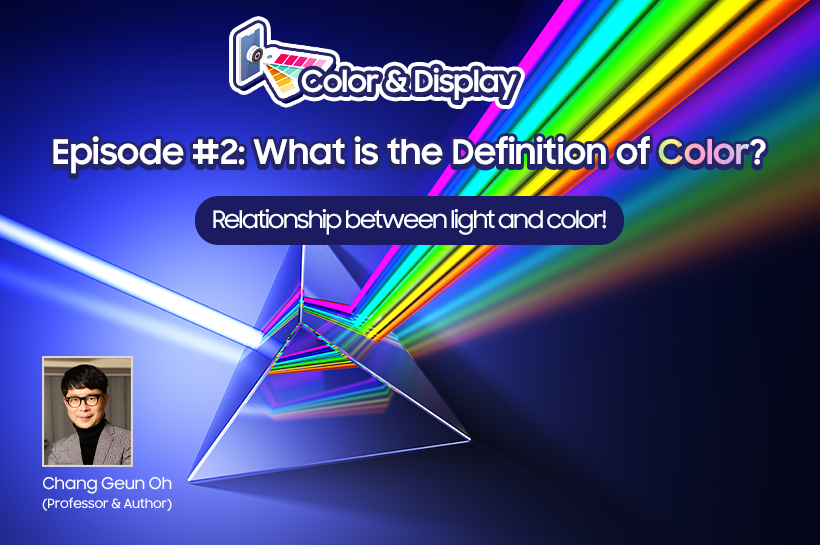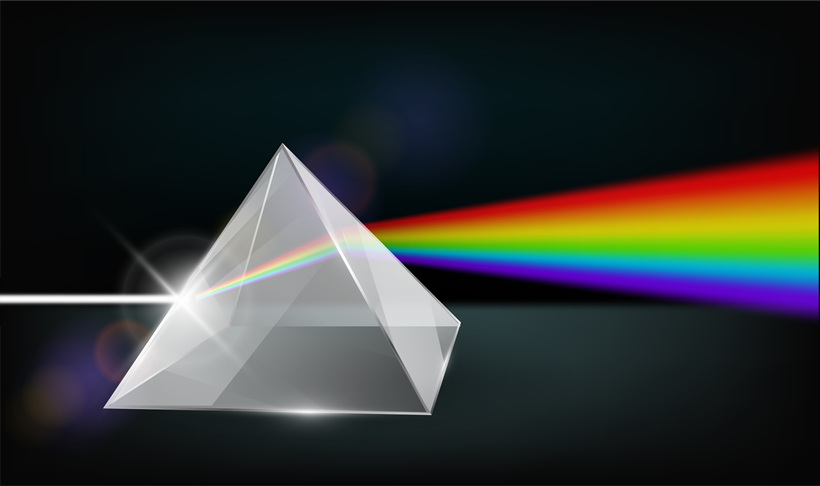
Which came first: the chicken or the egg?
It is a story that everyone should have heard and pondered at least once in their lives. That's really debatable. If the egg came first, who laid the egg, and if the chicken came first, how was the chicken born? The interesting story of biting a tail like this is also hidden in the colors. Today, let's look at the relationship between light and color, from space to smartphone screens.
Which Came First: Light or Color?

The work announced as the winner in the Under 18 category at this year's Science Photographer's Competition hosted by the Royal Photographic Society in the UK was a photograph of a young man who discovered Newton's optical spectrum in everyday life. It is a photograph of a black silhouette that looks like the shadow of a young girl, and the rainbow color spectrum is spread in an oblique direction. The color of the rainbow pattern that stands out in the middle of the silhouette, like the contrast of black and white, draws attention while showing a strong contrast effect.
The combination of the color created by the sunlight penetrating the prism and the shadow created by the outline of the person can be a very simple idea, according to the awardee's comments. As long as there is sunlight and a prism, anyone can create an image, so why did the judges of the Royal Photography Association award this photo?
Perhaps that is why science is always in our daily life. The other works were painstakingly photographed images of the Arctic or deep-sea relics, which usually present the problem of global warming. By comparison, this photograph reveals the discovery of light and color that surrounds us all year round. It is proof of the principle of color that has been forgotten because it is so close.

It was common knowledge even before Newton that sunlight passing through a triangular prism produced a rainbow-colored pattern. However, it was unclear whether this color pattern was a component of sunlight itself or was due to the unique function of the prism. To answer this question, Newton proved the separation and mixing of colors at once by using two prisms in succession in sunlight entering the hole.
Newton declared that "all colors in the universe are made of light", but "rays are not stained by the color." It only has the power to evoke color.” This is because the light is a physical concept, and color is a psychological realm. Only light has properties that cause color.
The fact that sunlight can be separated into a color spectrum and the scattered colors can be collected again to create the original transparent light, as in Newton's experiment, leaves us with the question of whether light or color came first.
Physics of Light | Light is the Wavelength.
In physics, light is defined as electromagnetic radiation. Color is recognized in the wavelength of visible light, which is a part of electromagnetic waves. If you look at the relationship between light and color from the point of view of a human who pretends to be the master of the earth, you can become a frog trapped in a well. This is because the wavelength of electromagnetic waves perceived by the human eye is actually less than half of the optical range that Newton called the spectrum. Half of the spectrum of sunlight is infrared, outside the red wavelength. We think of light as the rainbow spectrum because less than half the power of visible light is stronger and more abundant.

Among electromagnetic waves, what we call 'light' in our daily life is divided according to the wavelength range. The wavelength increases in the order of ultraviolet, visible, infrared, microwave, radio waves, etc.
Gamma rays, which are a type of radiation, have the smallest wavelength with 10 picometers (pm), or 100 millionths of a millimeter (mm). The more familiar radiation, X-rays, also has a small wavelength in the range of 10 picometers (pm) to 10 nanometers (nm). Ultraviolet ranges from 1 to 400 nm, visible light from 400 nm to 800 nm, and infrared from 800 nm to 1 mm. In a small range of about 400 nm, the rainbow spectrum as we know it is gathered from purple to red. The common X-rays, ultraviolet rays, and infrared rays are invisible to the naked eye.
Although it is invisible to the naked eye, infrared rays can affect the image, so an infrared cut-off filter is attached to the camera sensor. X-rays are used to look inside invisible, and ultraviolet rays are used in daily life as a tanning or sterilizer principle. Therefore, each light has its own proper use.

Where does this abundant 'light' come from? Where does the light that the sun in the blue sky shines on the earth come from? Sunlight comes to Earth from the Sun, which is located outside the galaxy's countless stars. Most of the electromagnetic waves from the sun are filtered out by the Earth's atmosphere. Radio waves with several tens of meters wavelengths are reflected by the ionosphere, and ultraviolet rays that cause skin cancer are absorbed by the ozone layer. Gamma rays and X-rays, which risk radioactive contamination, are mostly absorbed by nitrogen and oxygen in the atmosphere. The Earth's electromagnetic field, which surrounds the outer atmosphere, acts as a shield that filters and blocks numerous hazards from space. Sunlight reaching the surface through this process provides nourishment to lives on Earth, but when it meets transparent air and water, it magically scatters and refracts. This is because light, which is an electromagnetic wave, vibrates.

If the propagation direction of light is set as the Z-axis, the magnetic field oscillates in the Y-axis direction, and the electric field oscillates in the X-axis direction at right angles to each other. By manipulating the characteristics of this vibration, a polarizing filter that is attached to a camera lens, display, or sunglasses is also used. When a polarizing filter is attached, the transparent diffuse reflection disappears, and the object becomes clear.
Wave – Particle, Duality of Light
Since light is an electromagnetic wave, various phenomena caused by the principle of wavelength can be understood with a little interest in science. All beings in the world emit light, and our bodies also generate electromagnetic waves. Appearance is perceived by sight, so you can quickly recognize who you are and what you look like, but it is difficult to notice that you are emitting an invisible light.

When we look at the screen of the infrared camera for body temperature measurement, which has increased during the COVID-19 pandemic, we recognize that we are emitting infrared rays ourselves. In this way, the numerous lights located outside human vision can only be proved true when they are translated into colors within the visual perception. Not only infrared rays but also extraterrestrial black holes and distant radio waves can be understood and analyzed only when they are drawn with visible colors.
Newton classified the spectrum of light into seven colors like a scale, but he did not accept the fact that light is a wave. At that time, the wave theory of light, which Huygens and Robert Hooke argued based on refraction and diffraction phenomena, was competing with the particle theory. However, when Newton sided with the particle theory, the tide turned completely.
In 1807, Thomas Young experimented with the interference of light and passed through the argument that light is a wave, and the wave theory gained power again. Then he fell into the trap of setting the medium of the wave as a hypothetical substance, ether.
It wasn't until the middle of the 19th century that James Clerk Maxwell succeeded in demonstrating an electromagnetic wave in an integrated way, and it was revealed that light was an electromagnetic wave. However, a long debate ensued over the fact that light has wave properties as well as particle properties. It was Albert Einstein's photon theory that resolved this debate more clearly. Since then, the long debate was settled with the establishment of quantum mechanics and the development of radiation particle accelerator technology; light generally has a wave-like nature, but in microscopic parts such as atomic energy collisions, light particles, that is, photons, are the properties of particles.
A World of Colors Expressed with Light
The sunlight that flies from the sun at a speed of 300,000 km/s in 8 minutes and 20 seconds and enters the earth creates a colorful world for us. Thanks to sunlight, we can detect every color in the spectrum of visible light.
If there is no light, does that mean there is no color? Yes. Color is created by light. The colors of the world we perceive are not the colors inherent in objects. This is because our eyes perceive the color that the object reflects.
It means that we misunderstand the color of light that is pushed out rather than absorbed as the inherent color of an object. Therefore, there is no red in red apples. Strictly speaking, first, long-wavelength photons diffusely reflected by a red apple enter our eyes. And when it is absorbed by L-photopsin inside the red cone of the retina, it is transmitted to the visual cortex of the brain via the optic nerve, where it is recognized as red.

The color-sensing cone consists of a red cone (L) that absorbs red photons, a green cone (M) for green photons, and a blue cone (S) for blue photons. In the retina, there are fewer blue cones than the other two elements, and they are concentrated only in the fovea of the eyeball. Colors are classified according to the strength of the signals transmitted to these three cones, and actual colorful colors are recognized by adding the contrast information of the rods. The principle that pixels are composed of red, green, and blue (RGB) in color displays is also based on the structure of our eyes' color sensing cells.

So, the display technology that expresses color with light is like embodying the principle of the deep universe before our eyes. Just as photons in the spectrum of light emitted by the sun 8 minutes ago enter our eyes to form vision, the change in the light emitted by the display device comes to us, creating a picture on the screen.
The human eye can distinguish tens of millions of colors. If a color is viewed as a combination of hue, saturation, and brightness, there are not many types of pure color. In the visible light region of 400 nanometers, even if the color is split by 1 nanometer, there are only 400 colors. By subtracting the marginal regions of green, purple, and red, which are not sensitive to visual perception, up to 250 colors can be distinguished. If you add changes in saturation and brightness to that, tens of millions of colors enter the realm of visual perception.
An 8-bit display device can display 256 levels of each color of red, green, and blue, and there are about 16.7 million combinations of colors. That's enough, but mankind has put a lot of effort into realizing a wider range of colors that we can't clearly distinguish but can feel mildly. Digital camera and display technologies using a 10-bit color scheme that is much wider than 8-bit have also been implemented.

Recently, OLED displays that emit light by themselves have been popularized beyond LCD displays that show the screen through a backlight and color filter. Just like the colors of nature viewed directly under sunlight with the naked eye, display devices are now entering an era where high-resolution images are viewed in a wide-band color system. If quantum mechanics application technology develops further, won't a display that freely controls the photon itself show it as ‘real’ someday?

Just as the sunlight that flew through the vacuum of outer space showed us the wide world, the moment when you can feel the universe even on the smartphone screen in the palm of your hand is right before your eyes. The art of making the invisible visible to our eyes is itself wonderful.

